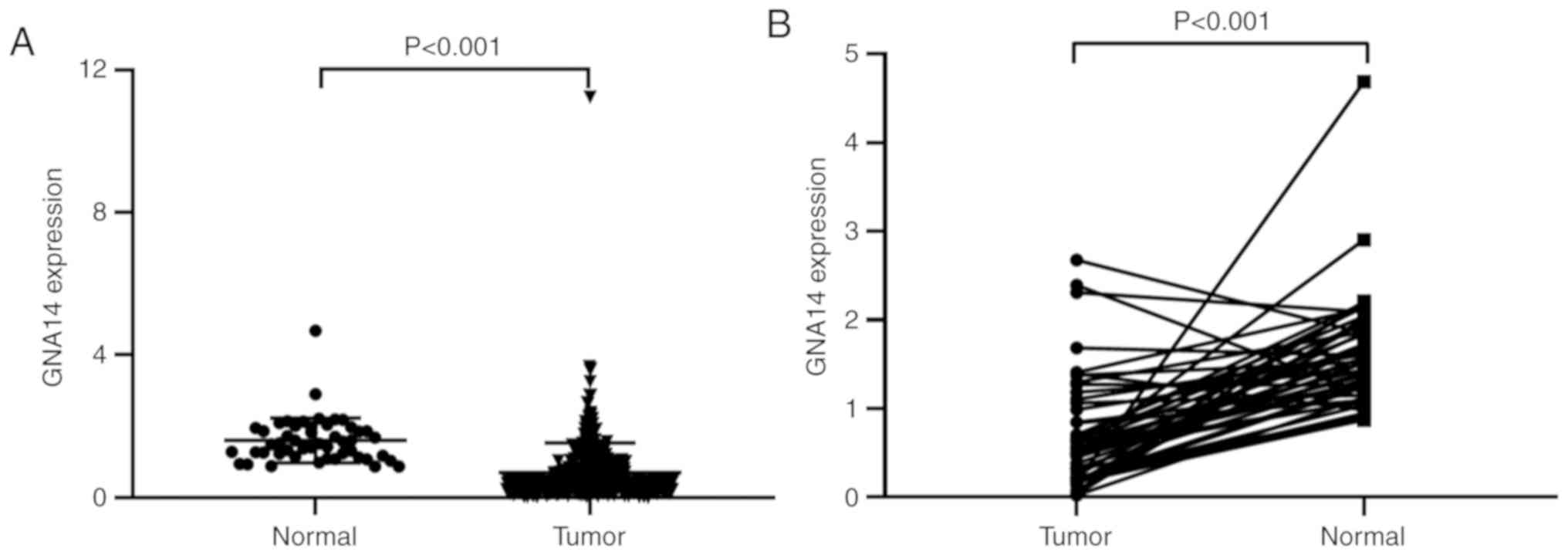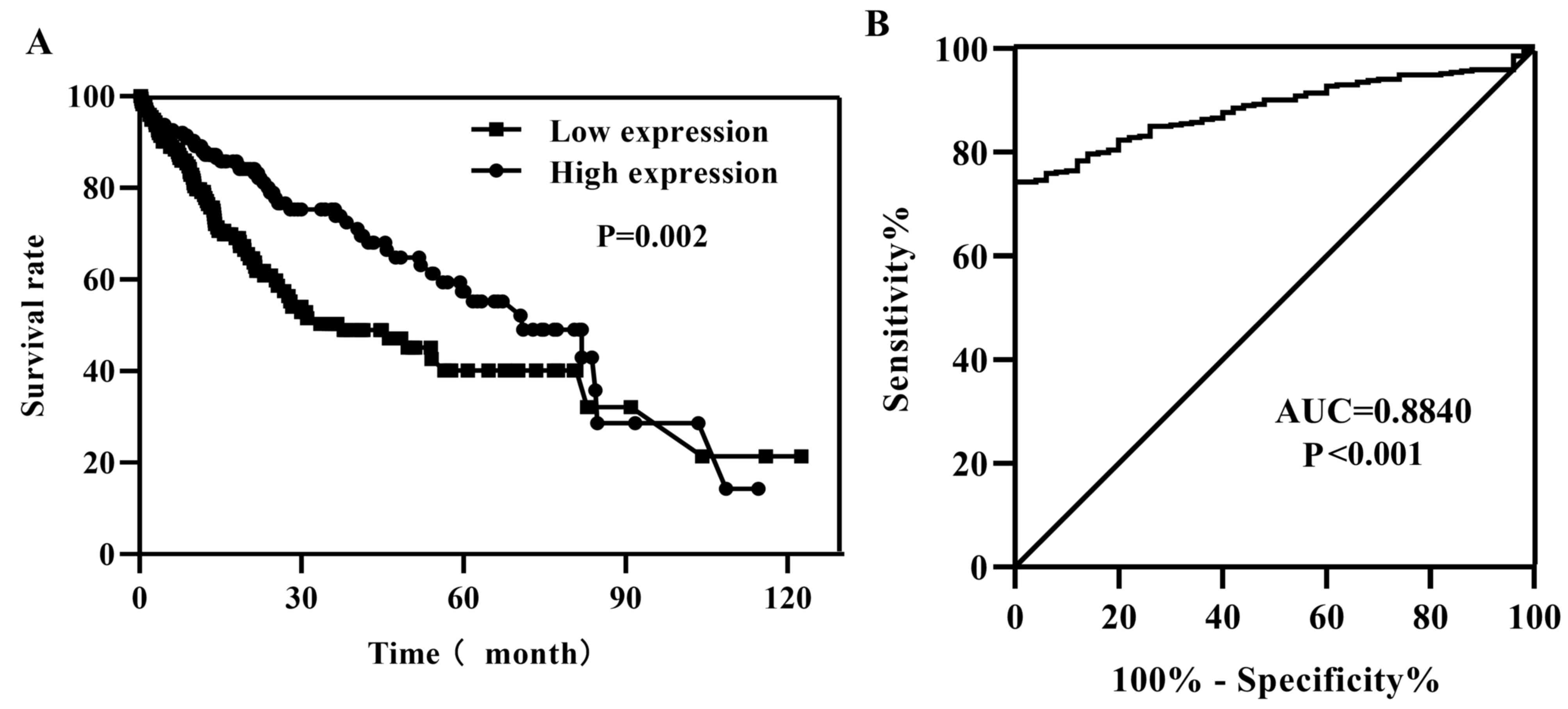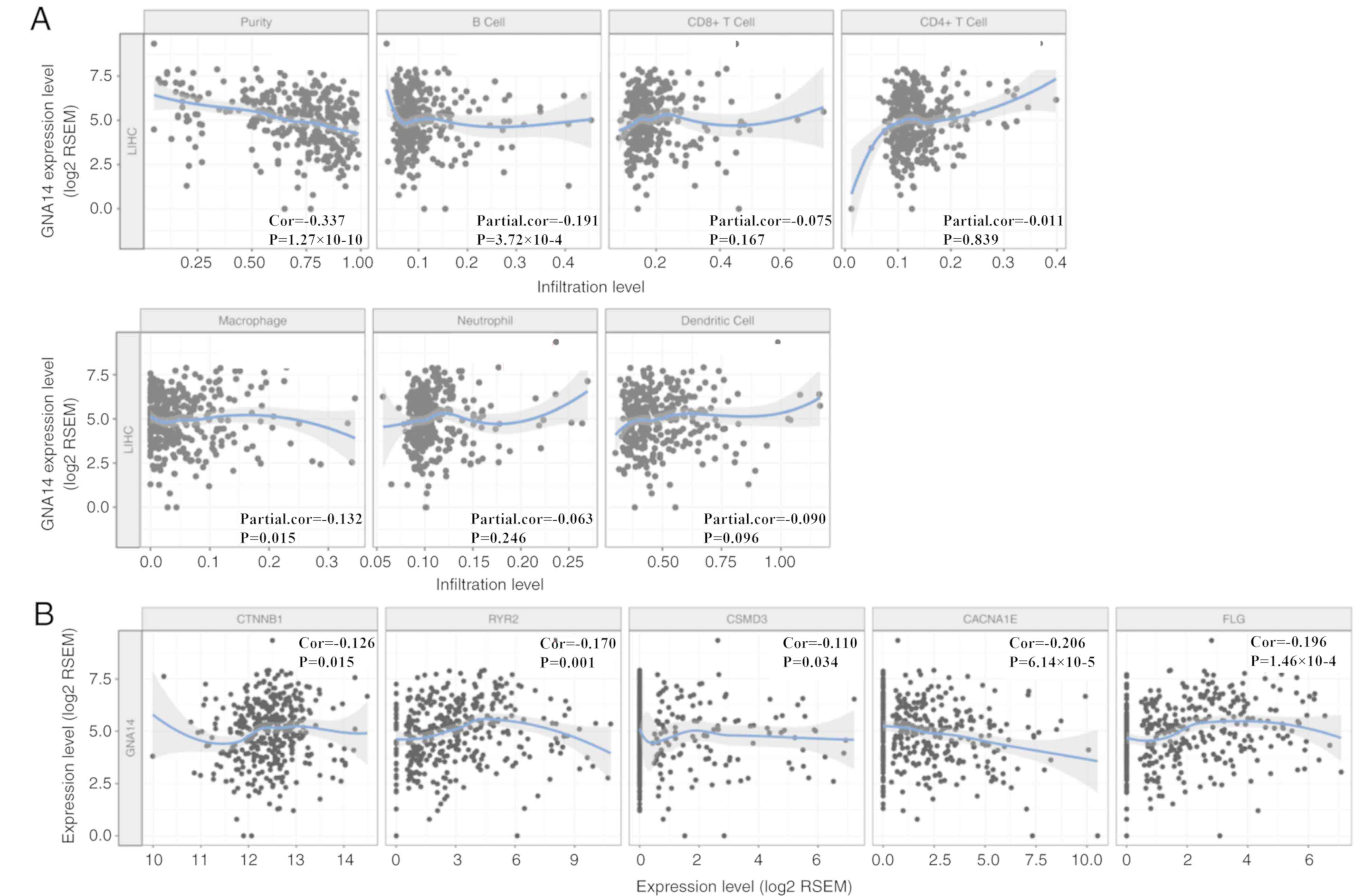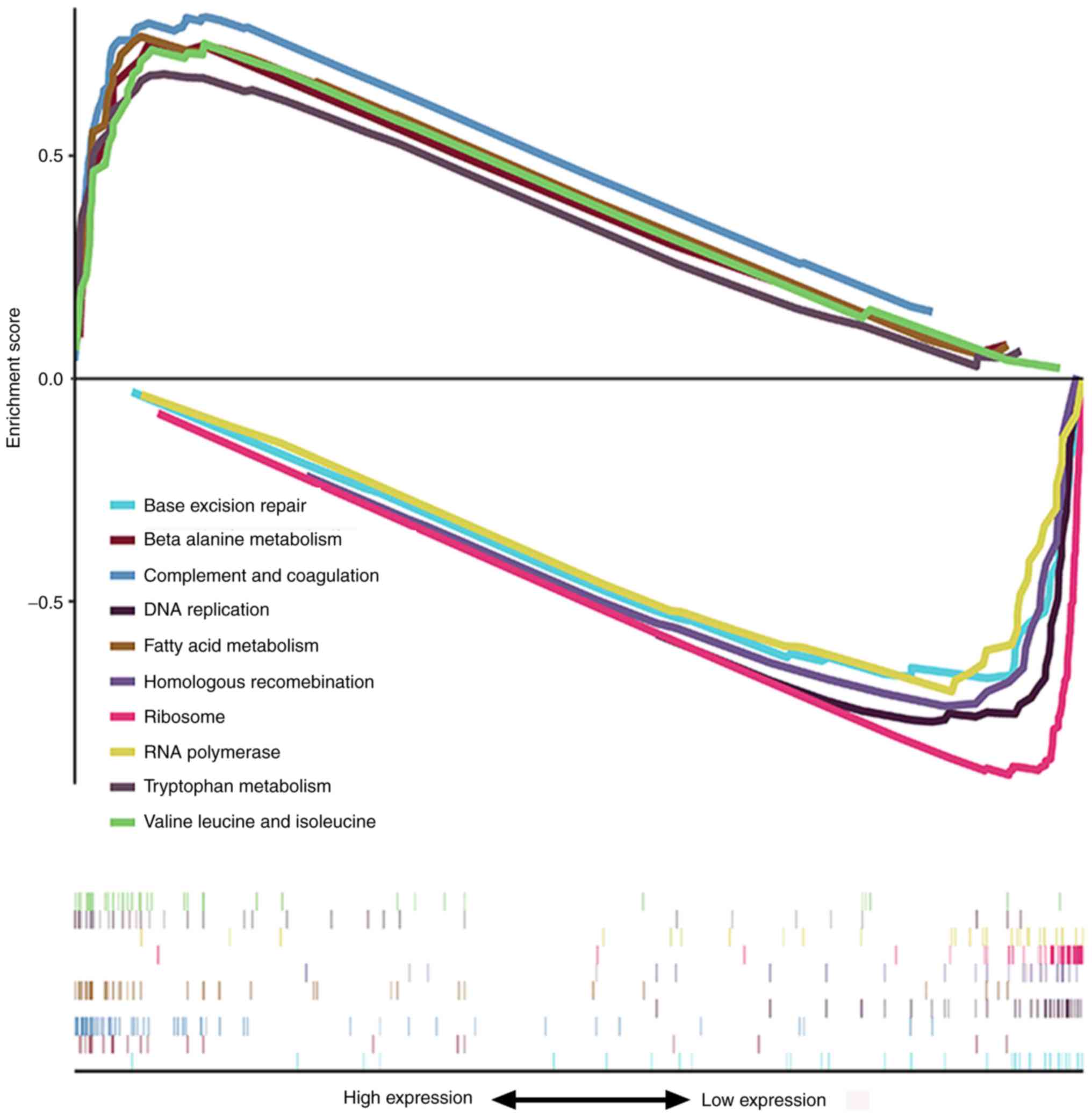Downregulation of GNA14 in hepatocellular carcinoma indicates an unfavorable prognosis
- Authors:
- Published online on: April 15, 2020 https://doi.org/10.3892/ol.2020.11538
- Pages: 165-172
-
Copyright: © Yu et al. This is an open access article distributed under the terms of Creative Commons Attribution License.
Abstract
Introduction
Liver cancer was the second leading cause of cancer-associated mortality worldwide in 2015 (1). Patients with HCC have no noticeable symptoms, making an accurate diagnosis challenging; therefore, effective and efficient treatment of HCC should be available at a much earlier stage, and novel biomarkers are required to improve earlier diagnosis of HCC and guide clinical management (2,3).
HCC is associated with increased expression levels of α-fetoprotein (AFP) (4). AFP is a serum glycoprotein that has been widely used as a conventional biomarker for HCC (5). However, the expression levels of AFP remain normal in >30% of patients with HCC at the time of diagnosis. In addition, relatively low AFP expression levels have been identified in approximately 30% of HCC (5). Although AFP is often used in combination with ultrasound for an accurate diagnosis of HCC, novel biomarkers may improve the diagnostic accuracy and detection rates (6,7).
Guanine nucleotide-binding protein subunit α (GNA) is a member of the guanine nucleotide-binding (G protein) family that serve as modulators or transducers in miscellaneous transmembrane signaling systems (8,9). Mutations in G protein subunits α14 (GNA14), αQ (GNAQ) and α11, are involved in ~50% of cherry hemangiomas and cherry-like hemangiomas, and pathological and molecular studies have demonstrated common functions of GNA14 mutations in vascular neoplasms (10). In addition, GNA14 silencing has been demonstrated to impair the proliferation of endometrial carcinoma cells by enhancing apoptosis and inducing cell cycle arrest (11). Additionally, somatic activating mutations in GNA14 induce the activation of the MAPK signaling pathway and contribute to the occurrence and development of congenital and sporadic vascular tumors, providing novel insight into the underlying mechanisms of carcinogenesis (12).
The present study investigated the prognostic value of GNA14 expression levels in HCC according using data from The Cancer Genome Atlas (TCGA). Additionally, biological processes and signaling pathways associated with GNA14 that may be involved in the molecular pathogenesis of HCC were identified based on the Gene Set Enrichment Analysis (GSEA) analysis. Overall, the present study aimed to explore the role of GNA14 in HCC.
Materials and methods
Data sources
RNA-sequencing (RNA-seq) data (workflow type, htseq-counts) and matching clinical data of 377 patients were obtained from the Genomic Data Commons data portal (https://portal.gdc.cancer.gov/) in June 2019, including information from TCGA database and the Therapeutically Applicable Research to Generate Effective Treatments program. The clinicopathological characteristics included age, sex, histological grade, clinical stage, T, N and M staging (13). According to a previous study (14), the processing of data and further analysis were conducted to explore the associations between GNA14 expression levels and clinicopathological characteristics in HCC. An unpaired t-test was performed to analyze the difference between tumor and normal samples.
Integrative Molecular Database of Hepatocellular Carcinoma (HCCDB) analysis
The HCCDB (http://lifeome.net/database/hccdb/) (15) is an integrated molecular database of HCC with 15 HCC gene expression datasets including 3,917 samples. The HCCDB includes 13 datasets from the Gene Expression Omnibus database and 2 RNA-seq datasets from TCGA liver hepatocellular carcinoma (LIHC) and the International Cancer Genome Consortium (ICGC) databases to explore the expression levels of GNA14 mRNA in HCC.
Oncomine database analysis
Oncomine is a cancer microarray database (oncomine.org/) containing 715 datasets and 86,733 cancer samples (16). In the present study, Oncomine was used to further assess the expression levels of GNA14 in HCC and adjacent normal tissue. The parameters were set as fold-change ≥2 and P<0.05, and the top 10% of ranked genes were exhibited.
DNA methylation level of GNA14
The DNA methylation levels of GNA14 were analyzed using the Methylation in Human Cancer database (MethHC) (methhc.mbc.nctu.edu.tw/) (17), a comprehensive database of DNA methylation and gene expression in human cancer. Unpaired t-tests were performed to analyze the difference between tumor and normal samples.
Tumor Immune Estimation Resource (TIMER) database analysis
A systematic assessment of the correlation between different immune cells, such as B cells, CD4+ T cells, CD8+ T cells, neutrophils, macrophages, and dendritic cells, and GNA14 expression levels across different types of cancer were performed using the TIMER database (https://cistrome.shinyapps.io/timer/) (18).
GSEA
Gene set enrichment analysis (GSEA) was conducted using c2.cp.kegg.v6.0.symbols.gmt as a reference gene set (software.broadinstitute.org/gsea/) (19). A list of genes was obtained from GSEA to account for the survival differences in patients with differential expression levels of GNA14. Gene set permutations were analyzed 1,000 times. In addition, the normalized enrichment score, normalized P-value and false discovery rate (FDR) q value were applied to filter the correlative pathways.
Statistical analysis
Statistical analysis was performed using R software version 3.6.0 (http://www.R-project.org/) (20), R studio software version 1.2.5019 (21) and GraphPad Prism version 8.0 software (GraphPad Software, Inc.) for data processing and analysis. All data were represented as mean ± standard deviation (SD). According to the median value of GNA14 expression levels in HCC tissues, patients were divided into low and high GNA14 expression groups. Survival analysis was conducted by the Kaplan-Meier method. Wilcoxon signed-rank test and log regression were used to analyze the association of clinicopathological characteristics and GNA14 expression levels. The univariate and multivariate Cox proportional hazards model was performed to evaluate the prognostic value of GNA14 expression. Receiver operating characteristic (ROC) curves were constructed using log-rank tests to evaluate the diagnostic value of GNA14 expression in HCC. P<0.05 was considered to indicate a statistically significant difference.
Results
Patient characteristics
Clinical and RNA-seq data of 377 patients with primary HCC, including 377 HCC and 50 adjacent normal tissues, were obtained from TCGA database and are listed in Table I. Of the 377 patients, 122 (32.4%) were female and 255 (67.6%) were male, with a median age of 61 years at diagnosis, ranging between 16 and 81 years. The distribution of conventional histological grades G1–4 was 15.4, 49.0, 32.4 and 3.2%, respectively. In addition, division of the patients based on clinical stage resulted in 125 (51.9%) patients with stage I, 60 (24.9%) patients with stage II, 55 (22.8%) patients with stage III and one (0.4%) patient with stage IV disease. There were 128 (50.4%) patients with T1 stage, 65 (25.6%) with T2 stage disease, 54 (21.3%) with T3 stage disease and 7 (2.8%) with T4 stage disease. Moreover, only one (0.4%) patient had confirmed N1 status, 177 (69.7%) with N0 status and others (29.9%) with Nx status. Additionally, one patient (0.4%) had confirmed M1 status, 186 (72.9%) with N0 status and others (26.7%) with Nx status.
Differential expression of GNA14 in HCC
As presented in Fig. 1A, GNA14 expression levels were evaluated in multiple types of the tumor using the TIMER database. GNA14 expression levels were significantly decreased in bladder urothelial carcinoma, breast invasive carcinoma, cholangiocarcinoma, colon adenocarcinoma, esophageal carcinoma, head and neck squamous cell carcinoma, kidney chromophobe, kidney renal clear cell carcinoma, kidney renal papillary cell carcinoma, LIHC and other types of cancer. The downregulation of GNA14 expression levels in HCC tissues was further verified using HCCDB and Oncomine (Fig. 1B and C). Therefore, the differential expression of GNA12 was observed in liver cancer tissues compared with normal liver tissues using multiple databases.
Association between GNA14 expression levels and clinicopathological characteristics
RNA-seq data and clinical information of 377 patients with HCC from TCGA were used to analyze the association between GNA14 expression levels and patient clinicopathological characteristics. Based on TCGA-LIHC data using an unpaired t-test, the expression of GNA14 was downregulated in HCC tissues compared within the normal tissues (P<0.001; Fig. 2A). Moreover, expression of GNA14 in HCC was lower compared with that in adjacent non-cancerous tissue (P<0.001; Fig. 2B). In addition, univariate logistic regression revealed that GNA14 expression levels were associated with histological grade [odds ratio (OR), 0.114; P=0.009), clinical stage (OR, 0.418; P=0.001) and T stage (OR, 0.508; P=0.013) in HCC (Table II). These findings suggested that reduced expression levels of GNA14 were associated with an advanced histological grade, clinical stage and T stage in HCC.
Survival outcomes and multivariate analysis
According to the median value of GNA14 expression levels in HCC tissues, patients were divided into low and high GNA14 expression groups. Kaplan-Meier survival analysis of data from TCGA-LIHC indicated that low GNA14 expression levels were associated with a less favorable survival rate compared with that of patients with high GNA14 expression (P=0.002; Fig. 3A). To investigate the characteristics of GNA14 as a potential tumor marker in HCC, ROC curve analysis was performed, and the area under the ROC curve was 0.8840 (P<0.001; Fig. 3B), indicating that GNA14 expression levels were a potential tumor marker for the diagnosis of HCC. Additionally, univariate Cox regression analysis indicated that low expression levels of GNA14 were associated with unfavorable survival [hazard ratio (HR), 0.527; 95% confidence interval (CI), 0.351–0.791; P=0.002, Table III). Other clinicopathological features such as clinical stage and T stage were also associated with less favorable survival (Table IIIa). In addition, multivariate Cox regression analysis revealed that low expression levels of GNA14 were associated with unfavorable survival (HR, 0.636; 95% CI, 0.425–0.953; P=0.028; Table IIIb. These findings indicated that GNA14 expression levels may have potential as a novel predictor for survival in HCC.
Table III.Association between overall survival and clinicopathological features in patients with hepatocellular carcinoma in The Cancer Genome Atlas Liver Hepatocellular Carcinoma database using Cox regression and Multivariate Cox regression analysis. |
DNA methylation analysis of GNA14 in HCC
The methylation levels across the GNA14 gene regions, including the promoter, TSS1500, TSS200, the 5′ untranslated region (5′UTR), CpG islands and N shores, were assessed in HCC using the MethHC database. As presented in Fig. 4, the levels of GNA14 DNA methylation were increased in HCC compared with the normal liver tissues in all analyzed regions, such as the promoter, TSS1500, TSS200, the 5′ untranslated region (5′UTR), CpG islands and N shores.
Association of tumor-infiltrating immune cells (TIICs) with GNA14 expression levels in HCC
As presented in Fig. 5A, GNA14 expression levels were partially correlated with the number of infiltrating B cells (partial correlation, −0.191; P<0.001) and macrophages (partial correlation, −0.132; P=0.015) in HCC as determined by the TIMER database. In addition, GNA14 expression levels were partially negatively correlated with catenin beta 1 (CTNNB1; partial correlation, 0.126; P=0.015), ryanodine receptor 2 (RYR2; partial correlation, 0.17; P=0.001), filaggrin (FLG; partial correlation, 0.196; P<0.001), CUB and Sushi multiple domains 3 (CSMD3; partial correlation, −0.11; P=0.034) and calcium voltage-gated channel subunit alpha1 E (CACNA1E; partial correlation, −0.206; P<0.001) expression levels in HCC (Fig. 5B). The results showed that the low expression of GNA14 might be closely related to immunotherapy.
Pathway enrichment analysis
GSEA was used to identify signaling pathways enriched in high and low GNA14 expression groups. As presented in Fig. 6 and Table IV, in the low GNA14 expression group, the significantly enriched signaling pathways were ‘ribosome’, ‘DNA replication’, ‘homologous recombination’, ‘RNA polymerase’ and ‘base excision repair’. By contrast, ‘complement and coagulation cascades’, ‘fatty acid metabolism’, ‘valine, leucine and isoleucine degradation’, ‘beta-alanine metabolism’ and ‘tryptophan metabolism’ were enriched in the high GNA14 expression group. These results showed that the low expression of GNA14 was closely related to several tumor-related signaling pathways.
Table IV.Pathways were enriched in guanine nucleotide-binding protein subunit α14 expression differential phenotype. |
Discussion
Recent studies have suggested a potential role for GNA14 in HCC. For example, activating mutations in GNAQ and GNA14 are frequently presented in hepatic small vessel neoplasms (22). A recent study on aberrant DNA methylation of differentially expressed genes in HCC has also revealed that GNAQ serves as a hub gene (23). Additionally, a previous study revealed that GNA14 exhibited enhanced methylation in HCC compared with adjacent non-cancerous tissue (24). To best of our knowledge, the association between GNA14 expression levels and HCC prognosis has not been elucidated to date. In the present study, the role of GNA14 in HCC was investigated using bioinformatics analysis.
A previous study of the GSE6764 gene expression dataset in the Gene Expression Omnibus database revealed that the expression levels of GNA14 were reduced in HCC tissues compared with normal liver tissue (25). In addition, a CpG island methylation phenotype-associated prognostic model involved in the expression of PLEKHB1, ESR1, SLCO2A1, and GNA14 was trained and validated in HCC, serving as an independent prognostic factor for HCC (26). However, the role of GNA14 expression levels in diagnosis and prognosis of hepatocellular carcinoma is still unclear.
In the present study, the RNA-seq data were analyzed to explore the role of GNA14 in HCC. GNA14 was demonstrated to be downregulated in HCC compared with normal liver tissue, and these results were verified using the HCCDB and Oncomine databases. In the present study, GNA14 expression levels and their potential prognostic value were investigated. It was demonstrated that GNA14 is abnormally expressed in HCC, and the prognostic value of GNA14 in HCC was also investigated. The results showed that the downregulation of GNA14 in HCC was associated with an unfavorable prognosis, indicating that GNA14 might exert a crucial part in HCC. The results of the present study revealed that low GNA14 expression levels were associated with advanced clinicopathological features, including histological grade, clinical stage and T stage, poor survival outcomes and an unfavorable prognosis. To the best of our knowledge, the present study was the first to assess the prognostic value of GNA14 in HCC using bioinformatics analysis. To the best of our knowledge, the present study is the first to provide novel insight into the role of GNA14 expression levels in HCC.
DNA methylation is a major epigenetic modification that regulates gene expression and is crucial for tumor occurrence and development (27). In the present study, the methylation levels across the GNA14 gene regions, including the promoter, TSS1500, TSS200, 5′UTR, CpG island regions, and N shores, were assessed in HCC. The results indicated that downregulation of GNA14 was correlated with its hypermethylation in the promoter region and gene body region. Furthermore, the correlation between GNA14 expression levels and the numbers of TIICs was evaluated. Of note, GNA14 expression levels were partially correlated with the infiltration level of B cells and macrophages. Additionally, GNA14 expression levels were partially correlated with CTNNB1, RYR2, FLG, CSMD3 and CACNA1E expression levels in HCC.
GSEA analysis was performed in the present study using TCGA-LIHC data to explore the potential function of GNA14 in HCC. The ‘ribosome’, ‘DNA replication’, ‘homologous recombination’, ‘RNA polymerase’ and ‘base excision repair’ pathways were enriched in the low GNA14 expression group. ‘Complement and coagulation cascades’, ‘fatty acid metabolism’, ‘valine, leucine and isoleucine degradation’, ‘beta-alanine metabolism’ and ‘tryptophan metabolism’ were enriched in the high GNA14 expression group. These signaling pathways were regulated by GNA14 expression and may be crucial in the carcinogenesis of HCC. The results indicated that GNA14 expression might have potential prognostic value in HCC and might be an underlying biomarker for patients with HCC.
There were certain limitations to the present study. Firstly, the present study lacked experimental validation and functional research is needed to confirm the role of GNA14 in HCC in future research. Secondly, adjuvant chemotherapy may have effects on GNA14 expression and the information on patients who received adjuvant chemotherapy was not obtained. Lastly, cancer-specific survival was not analyzed in the present study. Unlike overall survival, cancer-specific survival excludes death due to causes unrelated to cancer. It would be more appropriate to use different survival terms to describe prognosis in future research.
In conclusion, GNA14 may have the potential to guide the diagnosis and treatment of HCC. Further experimental studies should be explored to verify the biological function of GNA14 in HCC.
Acknowledgements
Not applicable.
Funding
No funding was received.
Availability of data and materials
The datasets generated and/or analyzed during the current study are available in The Cancer Genome Atlas Research Network repository (http://cancergenome.nih.gov/).
Authors' contributions
TY, SL and WX designed the study. TY collected the data. SL contributed to data analysis and interpretation. TY and SL drafted and revised the manuscript. All authors read and approved the final manuscript.
Ethics approval and consent to participate
Not applicable.
Patient consent for publication
Not applicable.
Competing interests
The authors declare that they have no competing interests.
Glossary
Abbreviations
Abbreviations:
|
HCC |
hepatocellular carcinoma |
|
TCGA |
The Cancer Genome Atlas |
|
GNA14 |
guanine nucleotide-binding protein subunit α14 |
|
TIICs |
tumor-infiltrating immune cells |
References
|
Kulik L and El-Serag HB: epidemiology and management of hepatocellular carcinoma. Gastroenterology. 156:477–491.e1. 2019. View Article : Google Scholar : PubMed/NCBI | |
|
Llovet JM, Zucman-Rossi J, Pikarsky E, Sangro B, Schwartz M, Sherman M and Gores G: Hepatocellular carcinoma. Nat Rev Dis Primers. 2:160182016. View Article : Google Scholar : PubMed/NCBI | |
|
Kanwal F and Singal AG: Surveillance for hepatocellular carcinoma: Current best practice and future direction. Gastroenterology. 157:54–64. 2019. View Article : Google Scholar : PubMed/NCBI | |
|
Wang X and Wang Q: Alpha-fetoprotein and hepatocellular carcinoma immunity. Can J Gastroenterol Hepatol. 2018:90492522018. View Article : Google Scholar : PubMed/NCBI | |
|
Bai DS, Zhang C, Chen P, Jin SJ and Jiang GQ: The prognostic correlation of AFP level at diagnosis with pathological grade, progression, and survival of patients with hepatocellular carcinoma. Sci Rep. 7:128702017. View Article : Google Scholar : PubMed/NCBI | |
|
Marrero JA and Lok AS: Newer markers for hepatocellular carcinoma. Gastroenterology. 127 (5 Suppl 1):S113–S119. 2004. View Article : Google Scholar : PubMed/NCBI | |
|
Daniele B, Bencivenga A, Megna AS and Tinessa V: Alpha-fetoprotein and ultrasonography screening for hepatocellular carcinoma. Gastroenterology. 127 (5 Suppl 1):S108–S112. 2004. View Article : Google Scholar : PubMed/NCBI | |
|
Pierce KL, Premont RT and Lefkowitz RJ: Seven-transmembrane receptors. Nat Rev Mol Cell Biol. 3:639–650. 2002. View Article : Google Scholar : PubMed/NCBI | |
|
Bockaert J and Pin JP: Molecular tinkering of G protein-coupled receptors: An evolutionary success. EMBO J. 18:1723–1729. 1999. View Article : Google Scholar : PubMed/NCBI | |
|
Liau JY, Lee JC, Tsai JH, Chen CC, Chung YC and Wang YH: High frequency of GNA14, GNAQ, and GNA11 mutations in cherry hemangioma: A histopathological and molecular study of 85 cases indicating GNA14 as the most commonly mutated gene in vascular neoplasms. Mod Pathol. 32:1657–1665. 2019. View Article : Google Scholar : PubMed/NCBI | |
|
Wang J, Lv X, Xu F, Wei M, Liu C and Yang Y: GNA14 silencing suppresses the proliferation of endometrial carcinoma cells through inducing apoptosis and G2/M cell cycle arrest. Biosci Rep. 38:BSR201805742018. View Article : Google Scholar : PubMed/NCBI | |
|
Lim YH, Bacchiocchi A, Qiu J, Straub R, Bruckner A, Bercovitch L, Narayan D; Yale Center for Mendelian Genomics, ; McNiff J, Ko C, et al: GNA14 somatic mutation causes congenital and sporadic vascular tumors by MAPK activation. Am J Hum Genet. 99:443–450. 2016. View Article : Google Scholar : PubMed/NCBI | |
|
Vogel A, Cervantes A, Chau I, Daniele B, Llovet JM, Meyer T, Nault JC, Neumann U, Ricke J, Sangro B, et al: Hepatocellular carcinoma: ESMO Clinical Practice Guidelines for diagnosis, treatment and follow-up. Ann Oncol. 30:871–873. 2019. View Article : Google Scholar | |
|
Wu H and Zhang J: Decreased expression of TFAP2B in endometrial cancer predicts poor prognosis: A study based on TCGA data. Gynecol Oncol. 149:592–597. 2018. View Article : Google Scholar : PubMed/NCBI | |
|
Lian Q, Wang S, Zhang G, Wang D, Luo G, Tang J, Chen L and Gu J: HCCDB: A Database of hepatocellular carcinoma expression atlas. Genomics Proteomics Bioinformatics. 16:269–275. 2018. View Article : Google Scholar : PubMed/NCBI | |
|
Rhodes DR, Yu J, Shanker K, Deshpande N, Varambally R, Ghosh D, Barrette T, Pandey A and Chinnaiyan AM: ONCOMINE: A cancer microarray database and integrated data-mining platform. Neoplasia. 6:1–6. 2004. View Article : Google Scholar : PubMed/NCBI | |
|
Huang WY, Hsu SD, Huang HY, Sun YM, Chou CH, Weng SL and Huang HD: MethHC: A database of DNA methylation and gene expression in human cancer. Nucleic Acids Res. 43:(Database Issue). D856–D861. 2015. View Article : Google Scholar : PubMed/NCBI | |
|
Li T, Fan J, Wang B, Traugh N, Chen Q, Liu JS, Li B and Liu XS: TIMER: A web server for comprehensive analysis of tumor-infiltrating immune cells. Cancer Res. 77:e108–e110. 2017. View Article : Google Scholar : PubMed/NCBI | |
|
Subramanian A, Tamayo P, Mootha VK, Mukherjee S, Ebert BL, Gillette MA, Paulovich A, Pomeroy SL, Golub TR, Lander ES and Mesirov JP: Gene set enrichment analysis: A knowledge-based approach for interpreting genome-wide expression profiles. Proc Natl Acad Sci USA. 102:15545–15550. 2005. View Article : Google Scholar : PubMed/NCBI | |
|
R Core Team, . R: A language and environment for statistical computing. R Foundation for Statistical Computing; Vienna: 2012, http://www.R-project.org/ | |
|
RStudio Team, . RStudio: Integrated Development for R. RStudio, Inc.; Boston, MA: 2015, http://www.rstudio.com/ | |
|
Joseph NM, Brunt EM, Marginean C, Nalbantoglu I, Snover DC, Thung SN, Yeh MM, Umetsu SE, Ferrell LD and Gill RM: Frequent GNAQ and GNA14 mutations in hepatic small vessel neoplasm. Am J Surg Pathol. 42:1201–1207. 2018. View Article : Google Scholar : PubMed/NCBI | |
|
Cai C, Wang W and Tu Z: Aberrantly DNA Methylated-differentially expressed genes and pathways in hepatocellular carcinoma. J Cancer. 10:355–366. 2019. View Article : Google Scholar : PubMed/NCBI | |
|
Gao W, Kondo Y, Shen L, Shimizu Y, Sano T, Yamao K, Natsume A, Goto Y, Ito M, Murakami H, et al: Variable DNA methylation patterns associated with progression of disease in hepatocellular carcinomas. Carcinogenesis. 29:1901–1910. 2008. View Article : Google Scholar : PubMed/NCBI | |
|
Wurmbach E, Chen YB, Khitrov G, Zhang W, Roayaie S, Schwartz M, Fiel I, Thung S, Mazzaferro V, Bruix J, et al: Genome-wide molecular profiles of HCV-induced dysplasia and hepatocellular carcinoma. Hepatology. 45:938–947. 2007. View Article : Google Scholar : PubMed/NCBI | |
|
Li G, Xu W, Zhang L, Liu T, Jin G, Song J, Wu J, Wang Y, Chen W, Zhang C, et al: Development and validation of a CIMP-associated prognostic model for hepatocellular carcinoma. EBioMedicine. 47:128–141. 2019. View Article : Google Scholar : PubMed/NCBI | |
|
Kanwal R and Gupta S: Epigenetic modifications in cancer. Clin Genet. 81:303–311. 2012. View Article : Google Scholar : PubMed/NCBI |















